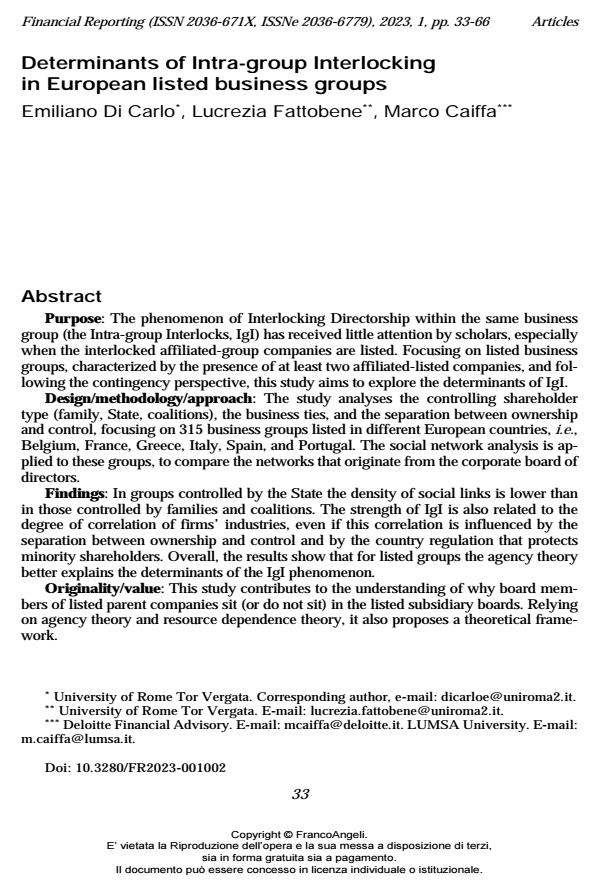Determinants of Intra-group Interlocking in European listed business groups
Journal title FINANCIAL REPORTING
Author/s Emiliano Di Carlo, Lucrezia Fattobene, Marco Caiffa
Publishing Year 2023 Issue 2023/1
Language English Pages 34 P. 33-66 File size 303 KB
DOI 10.3280/FR2023-001002
DOI is like a bar code for intellectual property: to have more infomation
click here
Below, you can see the article first page
If you want to buy this article in PDF format, you can do it, following the instructions to buy download credits

FrancoAngeli is member of Publishers International Linking Association, Inc (PILA), a not-for-profit association which run the CrossRef service enabling links to and from online scholarly content.
Purpose: The phenomenon of Interlocking Directorship within the same busi-ness group (the Intra-group Interlocks, IgI) has received little attention by scholars, especially when the interlocked affiliated-group companies are listed. Focusing on listed business groups, characterized by the presence of at least two affiliated-listed companies, and following the contingency perspective, this study aims to explore the determinants of IgI. Design/methodology/approach: The study analyses the controlling sharehold-er type (family, State, coalitions), the business ties, and the separation between ownership and control, focusing on 315 business groups listed in different Europe-an countries, i.e., Belgium, France, Greece, Italy, Spain, and Portugal. The social network analysis is applied to these groups, to compare the networks that originate from the corporate board of directors. Findings: In groups controlled by the State the density of social links is lower than in those controlled by families and coalitions. The strength of IgI is also relat-ed to the degree of correlation of firms’ industries, even if this correlation is influ-enced by the separation between ownership and control and by the country regula-tion that protects minority shareholders. Overall, the results show that for listed groups the agency theory better explains the determinants of the IgI phenomenon. Originality/value: This study contributes to the understanding of why board members of listed parent companies sit (or do not sit) in the listed subsidiary boards. Relying on agency theory and resource dependence theory, it also propos-es a theoretical framework.
Keywords: board of directors, business groups, intra-group interlocking, resource dependence, agency theory.
Jel codes: G30, G32, G39
Emiliano Di Carlo, Lucrezia Fattobene, Marco Caiffa, Determinants of Intra-group Interlocking in European listed business groups in "FINANCIAL REPORTING" 1/2023, pp 33-66, DOI: 10.3280/FR2023-001002